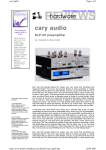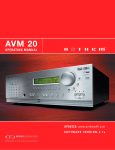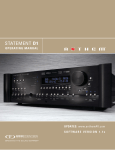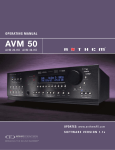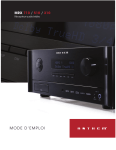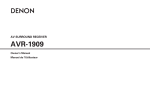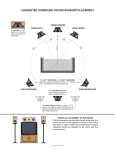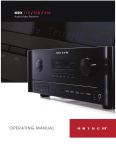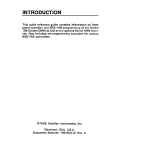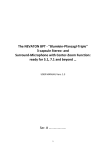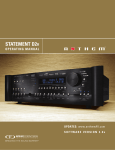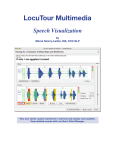Download from Being reprooucca m mis way. Anthem MRK 700 AudioA/ideo
Transcript
from Being reprooucca m mis way. Anthem MRK 700 AudioA/ideo Receiver In my last column, in November 2011,1 mentioned that preamplifierprocessors are generally at a price disadvantage in comparison to the same manu&cturer's A/V receivers. \-\' The economies of scale almost ensure this. Typically, to design a pre-pro, a manufacturer uses one of its AVR models as a platform; the result is most distinguished from its parent AVR by its lack of power amplifiers. Anthem is different. The company has long enjoyed success as a manufacturer of high-end pre-pros, and only recently has introduced its first range of AVRs, whose technology and philosophy are derived from Anthem's pre-pros. Not so surprisingly, in view of market demands, Anthem's MRX line of receivers is much less expensive than the Anthem or Anthem Statement pre-pros. A significant portion of this must be due to the fact that they're made in China rather than in North America like their pre-pros. Anthem's current top-model AVR is the MRX 700 ($1999). Unpacking the 35.4-lb MRX 700,1 was encouraged. It was more solid and rigid than I'd expected from the price and its front panel, though busy with controls, seems more businesslike than that of a typical AVR. The controls are clearly and usefully labeled. At top Anthem's $1999 MRX 700 pre/pro. left is a large navigation compass, at top right a volume control of similar size. Below the compass are buttons for Info, Setup, Menu, and Presets Scan, and below the volume knob is an identical array for Dolby Volume, Channels, Audio, and Mute. Between these groups is a row of eight sourceselection buttons. At bottom left are four jacks (Phones, USB, composite Video, and L-Audio-R), and at bottom right are four more buttons: Display, Zone, Zone 2 power, and Main power. While the front panel seems the very model of modern organization, the remote control was less intuitive in its organization; it took me a couple weeks to master it. Unfortunately, the backlight control button is clustered with others of similar size and shape, which makes it hard to find in the dark. A second, simpler remote is provided use with Zone 2. and instruments quite natural. The MRX 700's rear panel The MRX 700's fairly good has the requisite multiplicity spectral balance allowed for the of connections; with Canadian influence of room modes in the practicality, Anthem provides bass. I also switched briefly to full-page illustrations of the MRX 700's own amplifiers, it and the front panel in the and, as you might expect with manual. That made setup my all-Paradigm speaker system easy, and was helpful as I (Paradigm and Anthem share changed connections along the the same corporate parent), The MRX 700 has all the audio and video inputs and outputs Kal needed way. I hooked up the MRX there was sufficient oomph, 700 with HDMI cables to my and the balance was little cable box and high-definition audible during menu access; I could different from those with the disc players, and with coax for digital immediately hear the effects of changing Bryston 9B-SST—another Canadian input from the audio mode. After assigning and product, eh? The Bryston had the naming inputs, I was able to assign stronger grip on the bass and, despite the players. I used six Belkin Silver the room modes, was a bit cleaner Series RCA cables to connect the different default processing modes for outputs of my Oppo BDP-83SE each audio format. I also set up bass and through the low and midbass. I suspect universal Blu-ray player, and a set of" speaker management from experience that the differences might have been (and tape measure), and spent a week even smaller with Anthem Room Kubala-Sosna Anticipation RCAs to the inputs of my Bryston 9B-STT or two using no room correction, to get Correction (ARC), the company's power amplifier. The MRX 700 has a handle on the MRX 700's inherent room-correction software (included), sound quality. However, the outputs engaged, but I didn't get around to no balanced inputs or outputs. trying it with the Anthem's own amps. After power-up, I dove into the setup of my subwoofer and satellite speakers menus, whose graphics and red-anddidn't smoothly integrate, so I reset the The MRX 700 comes with a front speakers to Large. complete ARC toolkit: software, black color scheme suggest a brochure The overall sound was very calibrated microphone and cable, from the Royal Canadian Mounted and tripod mike stand. It's nearly the Police, and overlay the ongoing video impressive in both two channels and display. Audio signals, too, remain same version of ARC as is used in the surround, with the timbres of voices MUSIC IN THE ROUND Anthem Statement D2v processor: the MRX receivers have slightly less DSP power, and correction is limited to below 5kHz (the D2v can correct up to 20kHz). I've used ARC with the Statement D2v processor and, more recently, in its PBK incarnation, the bass EQ software for the Paradigm Sub-15 subwoofer, so I'm nearly as familiar with ARC as with Audyssey. ARC runs on a laptop and connects to the AYR via a USB or serial port, while Audyssey's connection is determined by the particular device it's installed in and can be run with or without wires. ARC can handle up to 10 mike positions; while Audyssey MultEQ Pro can handle up to 32 positions, less sophisticated versions of the software handle three, six, or eight mike positions. Used as fully automated procedures, ARC and Audyssey are equally easy to use, but ARC's Manual mode is friendlier than MultEQ Pro's, as it doesn't require a "key," doesn't ask for details of system setup (though this can be ignored in MultEQ Pro), and makes saving and retrieving settings a bit simpler. In addition, all ARCequipped devices can store two sets of EQ corrections, one each for Movies and for Music—but, of course, you can repurpose them. On the other hand, MultEQ Pro permits the hands-on editing of individual target curves, albeit only within ±3dB. With ARC you can adjust the room gain (a small mid-bass boost which preserves the warmth naturally caused by the acoustics of the typical listening room) and dictate how high in frequency the EQ is applied. Trie latter is particularly attractive to the many who believe that the correction of room modes should be limited to frequencies below the Schroeder Frequency, and that a system's highfrequency performance should be determined by speaker choice and placement and the user's taste. I ran ARC with the same nine mike positions I usually use. I chose a 2kHz upper limit for EQ to go along with the 3.9dB of room gain detected by ARC. The results were a definite improvement in the extreme bass— the subwoofer plot was smooth and extended—while the wider frequencyresponse swings in the main channels were restricted to the region below the crossover frequencies, which ARC put at 60Hz for the three Paradigm Studio/bos in the front, and at BOHZ for the two Studio/20s in the rear. stereoDhile.com • January 2012 Perhaps because the low end was cleaned up, or perhaps because I know that these speakers have sounded better, I became increasingly critical of a slight nasality in male voices, as well as a lack of presence in flutes, cymbals, and upper violin strings. The ARC graphs told me why: All of the main channels suffered from a 2-3dB trough from just below 1kHz to 6kHz. ARC corrected this up to about 2kHz, which resulted in an even more sharply defined depression above that point. So I extended the ARC correction to 5kHz (the MRX's default setting) but cut the room gain to 2dB and increased the subwoofer's upper cutoff to 120Hz. Voila! This sounded, and measured, pretty close With the MRX 700 I've been enjoying music via the Internet more than ever. to ideal, with the frequency response of every main channel within ±2dB, from above its crossover up to about 20kHz. The Sub-15 measured nearly flat down to 15Hz, and the XTZ measurement system revealed that ARC had virtually erased a large mode at 31.5Hz, as well as several smaller ones. Only the rear speakers still had a small modal bump at around 150Hz, though this was now 8dB lower than without ARC, I could sit back and just play the music. With everything I tried, in stereo or multichannel, I found it hard to find fault with the MRX 700. Voices were distinctive and rounded, with fricatives clearly defined. The low and midbass were tight and extended, as one might expect, but also packed a good wallop when that was called for. However, the real payoff was the overall integration of the sound, both harmonically and spatially. I have lived with this combination of speakers and room for many years, and it has never sounded better than with the Anthem MRX 700. Thaf s not to say that other pre-pros haven't been as satisfying, but there were differences. The Integra DHC-80.2 seemed a bit more open, buc die slightly warmersounding Anthem wasn't lacking in transparency. If anything, the MRX 700's reproduction of inner voices was more subtle. In terms of soundstage depth and the seamlessness of the illusion of surround sound, the MRX 700 was excellent, and shared with the eminent Classe SSP-800 the ability to re-create eerily distinct lateral voices without smearing. Although it is not multichannel, Internet radio streaming was more reliable and sounded cleaner through the Anthem MRX 700 than through the Arcam, Marantz, and Integra pre-pros I had to hand. In particular, RCO Live, the streaming service of Amsterdam's Royal Concertgebouw Orchestra, would cut out every so often with those models; the Anthem never did. Moreover, the imposition of AnthemLogic-Music, a proprietary algorithm that expands the signal to up to 6.1 channels, opened up the soundstage of these lossy compressed streams without affecting the tonal balance or frontal imaging. The reasons for the success of AnthemLogicMusic may be that it doesn't add a center channel, and that its use of the surround channels is very subtle. Whatever the factors, with the MRX 700 I've been enjoying music via the Internet more than ever. The MRX 700 is a fully competitive preamplifier-processor that lacks only the XLR outputs commonly found at this price, although the inclusion of an AVR's power amps makes for added value. However, the MRX 700 ($1999) is so similar to Anthem's MRX 500 ($1649) and MRX 300 ($1099) that a single user's manual serves for all three. The differences include the power output (respectively, 90W vs 75W vs 60W into 8 ohms, five channels driven) and a few features. Only the 700 includes HD radio and iTunes tagging, and the 300 lacks a USB input for flash drive or hard disk, and Internet radio via Ethernet. The MRX 700 also has a toroidal power transformer instead of the E-I cores in the 500 and 300. Remarkably, all three models share all other specs and features, including ARC. It might be safe to extrapolate from my conclusions about the MRX 700 and consider one of the less expensive models to use as a pre-pro or AVR, assuming its features and power output suit your needs. Bravo. • Kalman Rubinson (kal.rubinson@sorc. com) combines a career teaching neurobiology with shuttling between sunvund-suiifid-vitifitted homes in Manhattan and Connecticut. 63





